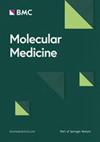ACE2 deficiency inhibits thoracic aortic dissection by enhancing SIRT3 mediated inhibition of inflammation and VSCMs phenotypic switch
IF 6
2区 医学
Q1 BIOCHEMISTRY & MOLECULAR BIOLOGY
引用次数: 0
Abstract
Thoracic aortic dissection (TAD) is an irreversible cardiovascular disorder with high mortality and morbidity. However, the molecular mechanisms remain elusive. Thus, identifying an effective therapeutic target to prevent TAD is especially critical. The purpose of this study is to elucidate the potential mechanism of inflammation and vascular smooth muscle cell (VSMCs) phenotypic switch in β-aminopropionitrile fumarate (BAPN)-induced TAD. A mouse model of TAD induced by BAPN and IL-1β -stimulated HVSMCs in vivo and in vitro models, respectively. ACE2 Knockdown mice treated with BAPN or without, and the TAD mouse model was treated with or without AAV-ACE2. Transthoracic ultrasound was conducted for assessment the maximum internal diameter of the thoracic aorta arch. RNA sequencing analysis was performed to recapitulate transcriptome profile changes. Western blot were used to detect the expression of MMP2, MMP9, ACE2, SIRT3, OPN, SM22α and other inflammatory markers. The circulating levels of ACE2 was measured by ELISA assay. Histological changes of thoracic aorta tissues were assessed by H&E, EVG and IHC analysis. We found that circulating levels of and the protein levels of ACE2 were increased in the TAD mouse model and in patients with TAD. For further evidence, ACE2 deficiency decelerated the formation of TAD. However, overexpression of ACE2 aggravated BAPN-induced aortic injury and VSMCs phenotypic switch via lowered SIRT3 expression and elevated inflammatory cytokine expression. ACE2 deficiency prevented the development of TAD by inhibiting inflammation and VSMCs phenotypic switch in a SIRT3-dependent manner, suggesting that the ACE2/SIRT3 signaling pathway played a pivotal role in the pathological process of TAD and might be a potential therapeutical target.ACE2 缺乏症可通过增强 SIRT3 介导的炎症和 VSCMs 表型转换抑制胸主动脉夹层的形成
胸主动脉夹层(TAD)是一种不可逆的心血管疾病,死亡率和发病率都很高。然而,其分子机制仍然难以捉摸。因此,找到预防 TAD 的有效治疗靶点尤为重要。本研究旨在阐明富马酸β-氨基丙腈(BAPN)诱导的 TAD 中炎症和血管平滑肌细胞(VSMC)表型转换的潜在机制。由 BAPN 和 IL-1β 刺激的 HVSMCs 分别在体内和体外诱导的 TAD 小鼠模型。ACE2 敲除小鼠接受或不接受 BAPN 治疗,TAD 小鼠模型接受或不接受 AAV-ACE2 治疗。经胸超声评估胸主动脉弓的最大内径。进行RNA测序分析以重现转录组的变化。Western blot用于检测MMP2、MMP9、ACE2、SIRT3、OPN、SM22α和其他炎症标志物的表达。循环中 ACE2 的水平是通过 ELISA 法测定的。通过 H&E、EVG 和 IHC 分析评估胸主动脉组织的组织学变化。我们发现,在 TAD 小鼠模型和 TAD 患者中,ACE2 的循环水平和蛋白水平均升高。更进一步的证据是,ACE2 缺乏会减缓 TAD 的形成。然而,过表达 ACE2 会通过降低 SIRT3 的表达和升高炎性细胞因子的表达,加重 BAPN 诱导的主动脉损伤和 VSMC 表型转换。缺乏 ACE2 可通过抑制炎症和 SIRT3 依赖性 VSMCs 表型转换来预防 TAD 的发生,这表明 ACE2/SIRT3 信号通路在 TAD 的病理过程中起着关键作用,可能是一个潜在的治疗靶点。
本文章由计算机程序翻译,如有差异,请以英文原文为准。
求助全文
约1分钟内获得全文
求助全文
来源期刊

Molecular Medicine
医学-生化与分子生物学
CiteScore
8.60
自引率
0.00%
发文量
137
审稿时长
1 months
期刊介绍:
Molecular Medicine is an open access journal that focuses on publishing recent findings related to disease pathogenesis at the molecular or physiological level. These insights can potentially contribute to the development of specific tools for disease diagnosis, treatment, or prevention. The journal considers manuscripts that present material pertinent to the genetic, molecular, or cellular underpinnings of critical physiological or disease processes. Submissions to Molecular Medicine are expected to elucidate the broader implications of the research findings for human disease and medicine in a manner that is accessible to a wide audience.
 求助内容:
求助内容: 应助结果提醒方式:
应助结果提醒方式:


